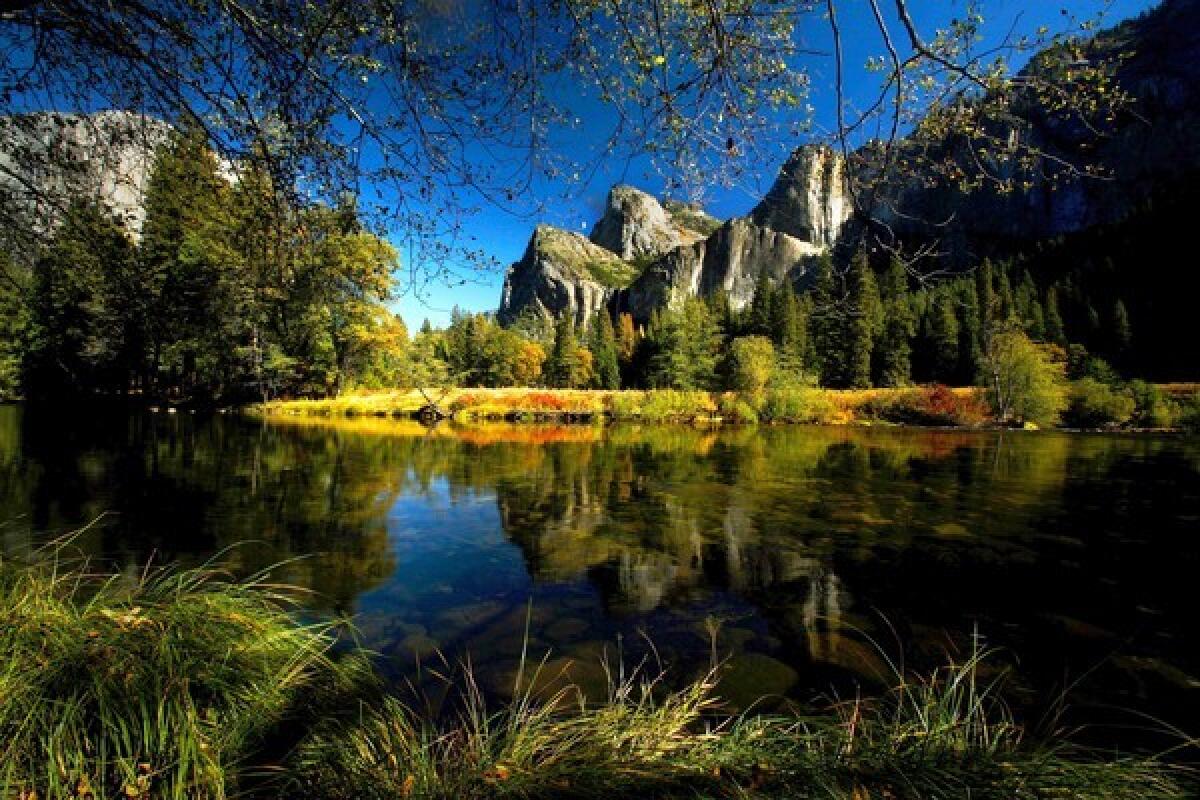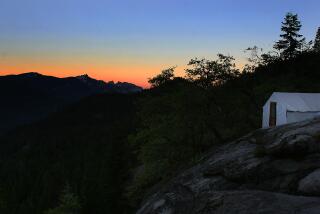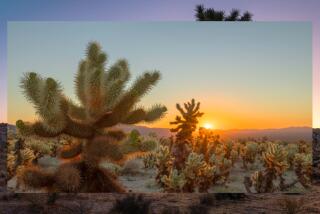Tips for photographing Yosemite

INTO THE DARKNESS
Don’t stop shooting just because it gets dark. Bring a flashlight, a tripod and your patience for long exposures that create dreamy starlight images of the night sky.
The time: Believe it or not, Yosemite has a night life. But it doesn’t involve dance floors or clubs. Bring your tripod and a trusty flashlight, and take a starlight walk around meadows and waterfalls.
The shot: Be prepared to experiment with long exposure times on your cameras. Set the shutter switch to bulb, attach a cable release (to minimize vibration) and mount the camera on a tripod. Even it doesn’t seem like there’s much light, the stars and moon will produce amazing results. I usually set my camera’s ISO setting to 640 or 800, leave the aperture wide open, and expose the frames for as long as it takes to see the stars, and rocks. Exposure times can last anywhere from 30 seconds to 5 minutes, sometimes even longer.
The effect: It’s worth losing sleep to get these shots. With longer time exposures, the stars begin to track across the frame and a jet or two may leave a few red and white streaks across the frame. Stars add a dazzling element to the composition of Half Dome or Yosemite Falls, and skies often render hues of deep cobalt blue or a slight magenta touch.
The tip: Go ahead and get up early to shoot sunrise, but then rest up for a late-night shoot because the real photographic fun happens after dark.
MAGICAL MOONBOWS
A moonbow lasts only an hour and happens only in May or June. The collision of moonlight and waterfall mist requires a 30-second exposure to capture a colorful moon bow.
The time: While most Yosemite visitors are asleep in their sleeping bags, photographers roam the valley in search of light – but not just any light. The shear granite walls, the roaring waterfalls, the clear skies and glorious topography can be shot with light from the stars and the moon. With a tripod in hand, a cable release for long exposures and some basic ideas about time exposures, anyone can conquer the night and come back with stellar photos.
The most popular phenomenon happens every year in May and June when the moon is full. Photographers from all over the world come to witness an event that happens when the full moon is in perfect alignment with the mist of the Yosemite Falls. They even have a name for it: “moonbow,” a feat of nature in which each component clicks into place like a Swiss timepiece. The full moon has to rise to a perfect angle, clearing the granite walls of the valley so light rays can diffract the heavy mist off the roaring waterfall. Each time this happens, there’s roughly a one-hour window of time before the angle of the moon changes and the moonbow disappears.
I made the short hike to the Lower Yosemite Fall with resident Yosemite photographer Nancy Robbins, who made a perfect moonbow picture several years ago by aligning it with the Big Dipper. (Now everyone wants a picture just like hers.) When I reached the viewing bridge and caught my first glimpse of the rainbow effect, I stood in absolute awe of the scene before me. The moonbow at first looked very opalescent and a bit silvery, but as my tired, middle-aged eyes gradually adjusted to the scene, the colors became more obvious -- and more fantastic.
The shot: I shot with a Canon 7D camera, with a 16mm-35mm zoom with the aperture set at f/4.5, and I left the shutter open for 30 seconds. Standing next to a roaring waterfall means bringing towels and plastic bags for your cameras and a rain poncho or waterproof jacket for yourself. While taking this shot, you’ll feel the heavy mist (which can feel like a heavy rain); just remember to wipe water drops off the front element or filter of the lens and keep your cameras dry.
The tip: Check the Yosemite National Park website for a chart that shows the time of the moonrise and optimum viewing times to see moonbows.
DAZZLING DOGWOOD
Use a 100mm macro lens to shoot creamy white dogwood blossoms in spring and create images of flowers so evocative you’ll swear you can smell them.
The time: Yosemite National Park is definitely known as an evergreen forest, but little known bit players don’t always get the attention they deserve. Broad-leafed trees like dogwood dot the landscape on the southern end of the park along the Merced River near the Pohono bridge as well as other spots throughout the valley. They start to show bright green buds in early to mid-April and burst into big white flowers by mid-May. The blooms stay on the trees well into May, but by Memorial Day, it is hard to find one that hasn’t started turning brown.
The shot: The object is to capture the delicate beauty of the white flowers dangling over the rushing waters of the Merced or framing a view of the waterfalls. The extreme close-up of water drops on a dogwood bloom was taken with a Canon 5D camera and a 100mm macro lens set at f/2.8 (for no depth of field) and shot against a dark backdrop near the Ahwahnee Hotel on a rainy April morning in April.
Tip: During fall, dogwood leaves turn from bright green to shades of yellow and red, so you still have an evocative subject even if you’ve missed the spring bloom.
THE PINHOLE CHALLENGE
The pinhole camera is a study in simplicity. The basics of light, composition and exposure play a role, but the unexpected results are what make it adventuresome.
The effect: Let’s face it -- every rock, twig and water feature in Yosemite has been photographed so many times that there are now petrified tripod holes on the banks of the rivers and in the meadows. To combat that feeling of sameness, many photographers are seeking to create alternative views by using techniques and cameras that are less than perfect.
The shot: I decided to break a few barriers for myself, and ventured into the park with a Holga wide view pinhole camera (Holga-120WPC). The camera is made of plastic, features a working aperture of f/135 and exposures (using 100 ISO film) average seven to 10 seconds. Use a long cable release, a tripod and a lot of patience in making these pictures. The beautiful simplicity of a plastic toy camera and the imperfect images that it renders made the camera a pleasure -- and added to my fun in the park.
Don’t expect any fancy optics. There is just a small, clear plastic disc below the shutter where a lens could be. There are a few tricks to advancing the film that didn’t make it onto the tiny instruction sheet that came in the box. Since the negative sizes are so huge (roughly 2 by 4.5 inches), remember to skip two frames between pictures or you’ll get one long continuous negative, as I did on my first try.
Every frame has black vignette edges, and the image is not perfectly sharp every time, but the results are fun; they remind me of pictures my father would take with his old Kodak Box Brownie.
The tip: Another trick worth trying is called cross-processing. I loaded several rolls of transparency film in one of the Holgas but had the transparency film processed in color negative chemistry. (Most labs will do it for you; just ask for your film to be cross-processed. ) The resulting images will be lime green in appearance, but once you scan the image and correct for the green in Photoshop, the images look slightly sepia, slightly magenta, with a hint of green. The final pictures look like the faded, old color prints from the ‘50s. The pinhole camera is a study in simplicity. The basics of light, composition and exposure still play a role, but the unexpected results are what make it adventuresome.
SLOW AND SPLASHY
The best way to produce a lyrical image of water pounding down a waterfall is to use a slow shutter speed that allows the water to “flow” through the frame.
The time: Sometimes photographers are storytellers, sometimes illustrators, and sometimes we just enjoy playing with the camera. There also are times when we can be all three.
When we’re photographing sports, we try to stop the action with fast shutter speeds; but when we photograph things in nature, we want to show the speed and grace in other ways.
The shot: The best way to produce a lyrical image of moving water is to use a slow shutter speed, allowing the water to “flow” through the frame. In the photo of the rushing waters of the Merced River, I used a tripod-mounted Canon EOS 1D Mark lll camera with a 70-200mm zoom lens set at 200mm. To achieve the effect, I shot the picture about an hour before sunset, using ISO 100, and camera settings of f/32 at 1/ 2.5 seconds and a cable release to minimize vibration.
The photo of fern spring was shot with a tripod-mounted Canon 5D camera and a 24-70mm zoom, set at 70mm. The camera settings were, ISO 50, f/20, a shutter speed of eight seconds and a cable release to minimize vibration.
The tip: Using long shutter speeds with water is nothing new, but it certainly is fun and adds another way to tell the story -- much better than stopping the action like a sports photographer.
SCALE IT BACK
Giant rock landmarks and waterfalls are the main subjects in Yosemite, but things like seed pods and bees can make for great photos with a macro lens at close range.
The effect: One of the coolest tools in my camera bag has to be the macro lens. I use a 100mm Canon that is one of my sharpest lenses. The trick to shooting with the macro lens is getting down low -- and I mean really low, like on your stomach, because most of the really fun nature stuff that looks good in macro is only a few inches off the ground. It also helps if you have a tripod with legs that swing way out and go almost flat. My carbon fiber Gitzo GT 1830 has levers that release the legs to swing to almost 90 degrees.
The shot: Once you choose a subject, isolate the center of interest by carefully focusing on only those parts of the frame you want in sharp focus, then choose an aperture that will give you a very shallow depth of field.
The photo with the bee hovering around the lupine flowers was shot near the redwoods in Wawona, near the south entrance to the park. It may look simple, but it actually took a while to compose, waiting for the right light and the bee to swing by for a visit. The picture was shot with a Canon 5D, a 100mm macro, set at 5.6 with a shutter speed of 1/2000th and the ISO was set at 200. I started looking around for this picture at 8 a.m. and wound up taking it two hours later.
The picture of the seeds falling out of a milkweed pod was next to a road in the Yosemite Valley. If I had been driving, I would have missed it; luckily, I found it during one of my evening walks. I made the picture with a Canon 5D camera, a Canon 100mm macro set at f/8 and a shutter speed of 1/320th, and an ISO rating of 200.
The tip: While the giant rock landmarks and waterfalls are the main events in Yosemite, things like seed pods and bees are the little things that can go unnoticed but make a great second act to the main events in the park. Macro pictures are everywhere, so look around and take your best shot.
More to Read
Sign up for The Wild
We’ll help you find the best places to hike, bike and run, as well as the perfect silent spots for meditation and yoga.
You may occasionally receive promotional content from the Los Angeles Times.





